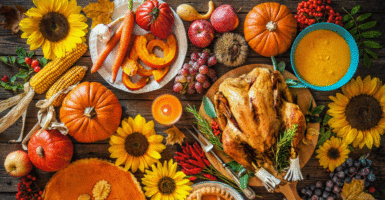This being the fourth Thursday of November, we turn our attention to the abundance on our tables and the blessings in our lives. (There is also no small number of folks who are deeply grateful for the end of election season.)
Let us also give thanks that the Obama administration will soon cease, albeit leaving behind more than 21,000 regulations that President Barack Obama’s regulators issued, and which increased regulatory costs by more than $100 billion annually.
The burden of this vast administrative state is crushing America’s entrepreneurial spirit, productivity, and economic growth.
Independent estimates find that total regulatory costs are exceeding $2 trillion annually—more than is collected in income taxes each year.
Indeed, there is virtually no aspect of our lives over which laws and ordinances do not reign. Even the Thanksgiving menu is laden with regulatory do’s and don’ts. Some may be justified as safeguarding public health and safety, but thousands of others are simply the meddling of an administrative state that is threatening to transform us into regulatory serfs.
Lest there be any doubts about the extent of the problem, forthwith is just a taste of the regulatory minutiae that control today’s menu:
Turkey. Title 9, Part 381.76, of the Code of Federal Regulations directs turkey inspectors on the proper method of examining a frozen bird, to wit: “If a carcass is frozen, it shall be thoroughly thawed before being opened for examination by the inspector. Each carcass, or all parts comprising such carcass, shall be examined by the inspector, except for parts that are not needed for inspection.”
Cranberries. Title 7, Part 929, establishes a “marketing committee” overseen by the U.S. Department of Agriculture to set quotas on the volume of cranberries shipped to handlers from growers in Massachusetts, Rhode Island, Connecticut, New Jersey, Wisconsin, Michigan, Minnesota, Oregon, Washington, and Long Island, New York. The grower “allotments” help to ensure that the price of cranberries remains artificially high.
Bread/Rolls. Title 21, Part 136, requires anything labeled as “bread” in a bakery to weigh one-half pound or more after cooling. To be legally called a “roll,” each unit must weigh less than one-half pound after cooling.
Potatoes. Title 7, Part 51.1546, dictates the proportion of allowable defects among specific grades of spuds. Potatoes graded as “U.S. No. 1” may not exceed the following tolerances at the point of shipping: 5 percent for external defects, 5 percent for internal defects, and not more than a total of 1 percent for potatoes that are frozen or affected by soft rot or wet breakdown. An entirely different set of tolerances apply to U.S. No. 1 potatoes while en route or upon reaching the destination, while similar standards are also set for “commercial” grade potatoes, “U.S. No. 2” potatoes, and “off-size” potatoes.
Green beans. Title 21, Part 155.120, defined green beans and wax beans as “the foods prepared from succulent pods of fresh green bean or wax bean plants conforming to the characteristics of Phaseolus vulgaris L. and Phaseolus coccineus L. The beans shall be one of the following distinct color types: (a) Green; or (b) Wax. The varietal type is either (a) beans having a width not greater than 1 1/2 times the thickness of the bean; or (b) beans having a width greater than 1 1/2 times the thickness of the bean.”
Cornmeal (for stuffing). Title 21, Part 137.275, distinguishes yellow cornmeal from cleaned white cornmeal: “Yellow cornmeal conforms to the definition and standard of identity prescribed by §137.250 for white cornmeal except that cleaned yellow corn is used instead of cleaned white corn.”
Pecans. Title 7, Part 65, requires “country of origin” labeling for pecans and a variety of other foods. The declaration may not contain abbreviations or flags. However, the adjectival form of the name of a country may be used to identify the country of origin—provided the adjectival form of the name does not appear with other words so as to refer to a kind or species of product.
All of this regulation raises a simple question: Who are the actual turkeys?
























